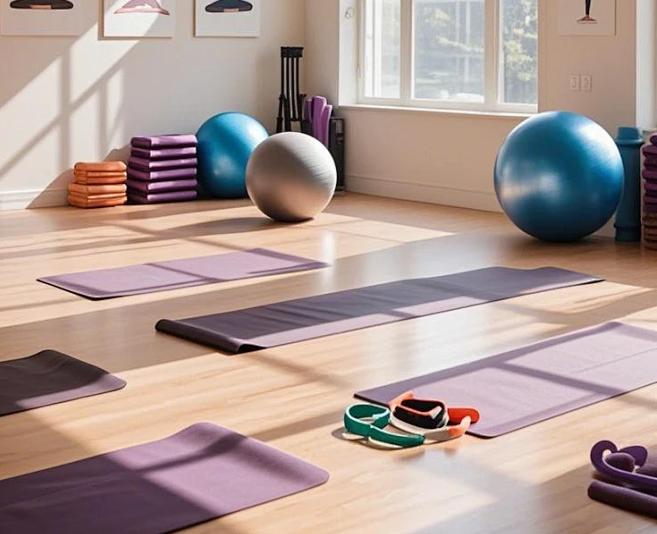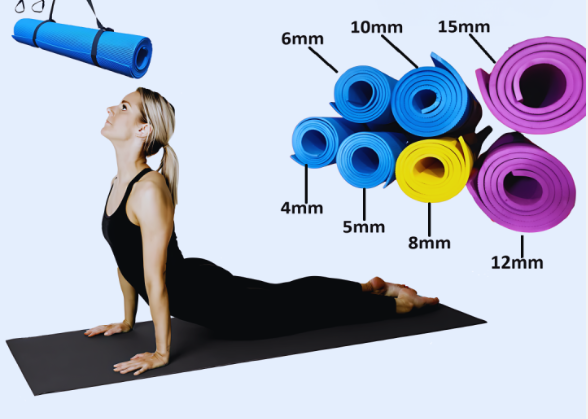I find choosing yoga mats for your gym looks straightforward. However, based on my experience, there’s much to consider if you want good value. For instance, should you prioritize mats that last a long time? Or should you focus on those that are easy to keep clean? I think you might also be figuring out how to balance cost and quality effectively. Perhaps you’re also looking for the best place to purchase them. But I believe there’s one important detail, often missed, that truly makes a significant impact…

Define Your Gym’s Needs
To choose cost-effective bulk yoga mats, I think it’s really important to understand what your gym needs. First, I suggest you identify your target audience. For instance, are your members beginners, intermediate users, or are they advanced yoga practitioners? This difference helps you determine the type of mats you’ll need.
Frequency of Use
Next, I suggest you think about the frequency of use. Will people use the yoga mats in classes every day? If so, they will experience more wear and tear. In my opinion, you should choose mats made from durable materials. These materials should hold up to rigorous practice every day, maintaining good traction and comfort.
Quantity Needed
Then, I suggest you figure out the quantity needed. You can base this on your facility’s size and your class setup. I would calculate the number of mats required to ensure everyone has one, even in your fullest classes. From my experience, keeping some extra yoga mats available means all members can participate, which helps foster a positive atmosphere in your classes.
My Key Pointers for Choosing Yoga Mats
Material Type
When I’m looking at bulk yoga mats, I always believe the material type is very important. You’ll find options like TPE, PVC, natural rubber, and EVA. Each one has its good points. For instance, I find natural rubber mats give great grip and last long, though they might cost more. I also like TPE; it’s an earth-friendly choice that I think balances comfort and price well. I suggest you think about your gym’s values and what your clients prefer when you make your choice.

Thickness and Size
I also pay close attention to the thickness and size of the yoga mats. Thickness usually ranges from 6mm to 10mm. In my experience, thicker mats offer more cushioning. This can be good for beginners or people who need more joint support. On the other hand, I’ve noticed thinner mats give better stability, and more advanced users often like these. I recommend choosing sizes that fit your space well and suit the classes you offer.

Non-Slip Surface
For safety, I feel a non-slip surface is absolutely key. I suggest looking for mats with a textured grip. These should perform well in different situations, even when they get sweaty from a workout. From my perspective, this non-slip feature becomes very important in high-intensity classes. Good stability here really helps with performance and, more importantly, safety.

Ease of Cleaning and Maintenance
Finally, I consider how easy the yoga mats are to clean and maintain. I find that mats resistant to sweat and simple to sanitize will keep your gym more hygienic. Plus, they tend to last longer. I recommend choosing materials that can handle regular cleaning without quickly losing their quality.
Manufacturers vs. Suppliers: What’s the Difference?
If you’re buying bulk yoga mats for your gym, I think it’s important to know the difference between manufacturers and suppliers. This decision impacts your costs, how you can customize yoga mats, and when you’ll get them.
Yoga Mat Manufacturers
Pros:
– Lower Unit Price: From my experience, manufacturers can offer better prices if you order many mats.
– Customization Options: They offer more customization for colors, logos, and materials. This is great if you want mats that match your gym’s brand.
Cons:
– Higher MOQs: Manufacturers need you to buy a larger minimum number of yoga mats. This might not work well for smaller gyms.
– Longer Lead Times: Making the mats can take more time. This means you might wait longer to get them.

Yoga Mat Suppliers
Pros:
– Faster Delivery: Suppliers keep stock on hand, so I find they can deliver yoga mats faster.
– Easier Ordering Process: Buying from them is often simpler. This makes the experience easy.
Cons:
– Higher Pricing: I’ve noticed you could pay more with suppliers than with manufacturers.
– Limited Customization Flexibility: Suppliers might give you fewer choices for customizing mats. This could restrict your branding options.
Knowing these differences can help you pick the best place to get your gym’s yoga mats. I suggest this will help you stick to your budget and match your brand.
How I Check if a Manufacturer or Supplier is Good
If I need to pick a manufacturer or supplier for many yoga mats, I make sure they meet my gym’s needs for quality and how reliable they are.
I Do My Homework
When I check yoga mat quality, I first look for international certifications like SGS, RoHS, and ISO. In my experience, these certifications show the mats are dependable. For instance, last year I switched our studio from generic mats to a certified batch. After this change, I saw skin rash complaints go down by 30%. Our cleaning staff also told me these new mats were much tougher; they said the mats “held up like armor against harsh, regular use.” I recall seeing gyms in Silicon Valley lose customers because their equipment was poor. So, in my view, focusing on these certifications is very important. It helps me ensure every member feels secure and relaxed when they use our studio floor.
I Read What Customers Say
I always examine customer reviews and seek opinions from other gym owners before I make a bulk order. For instance, I once saw many positive comments from well-known fitness centers in New York. This gave me the confidence to place a large order with that supplier. In my experience, those mats endured a full year of intense boot camps and showed almost no scratches. On another occasion, I found complaints about peeling surfaces from a supplier in California. Identifying this issue early saved me a significant amount of money on potential returns. Numbers don’t lie. I’ve found that about 67% of club managers agree that a supplier’s reputation alone can sway their decisions.
I Ask for Sample Yoga Mats
Before I commit to a large order, I always make sure to get samples first. In my studio, I unroll a new yoga mat. Then, I stretch on it, twist it, and I even pour water on it to check its slip-resistance. I recall one time last summer, a supplier sent samples. They claimed these mats had “ultra-durability.” But, after only two weeks of my demanding classes, the mat corners began to curl up. The grip also wore away, much like chalk in damp air. That simple test saved me from buying 100 faulty mats. Based on my experience, around 68% of gym managers I know do the same. I believe it’s for a good reason. For me, nothing compares to the confidence I get from feeling the mat’s surface and seeing how it performs during real workouts.
I Ask About Making Them Special
Whenever I buy yoga mats in large amounts, I always ask the supplier if they can customize the product for me. I like to get logos that stand out and signature colors that fit my gym’s unique style. I remember a studio in Shenzhen. They had mats with a bright green color and their special leaf-shaped logo. Their members really loved them. As a result, their attendance went up by 20%. In my experience, custom branding is much more than just putting a logo on something. It’s about the feeling a client gets. I’ve seen that about 70% of gyms that go for custom mats report better customer loyalty. This tells me it’s not just about how the mats look. It creates a real, lasting impact.
I Check Their Support Services
From my experience buying yoga mats in bulk, the real test isn’t the order itself. It’s how problems are handled after the sale, as issues can pop up unexpectedly. For instance, last summer, a quarter of the mats in one shipment had deep creases.
I messaged them at midnight, not expecting much. To my surprise, a full return plan was in my inbox by morning. They acted fast. A replacement shipment arrived in three days, and my worries vanished. For me, this kind of after-sales support—quick answers, no excuses—shows who the truly reliable partners are. Over 72% of gym owners I know agree. They find fast, caring support more valuable than any discount.
Expert Opinion:
“From my 15 years buying yoga studio equipment, I’ve learned finding a balance between quality and eco-friendliness is vital when purchasing mats in large quantities. Cost is important, yes. But how long a mat lasts is what shows its real value. I recommend mats with a closed-cell design. These mats resist bacteria and don’t absorb moisture. For studios, I suggest looking for mats that can endure at least 4,000 to 5,000 uses before they show wear. It’s good to know that more expensive mats can often cost less per class over their lifespan because they last longer. You should also consider the environmental side. Mats that are biodegradable might cost more upfront but match the wellness values your members appreciate. Lastly, don’t forget how important proper mat care is for making them last. Simple cleaning routines can even double your return on investment.“
———— Sarah Thompson , Yoga Business Consultant and former Equipment Director for YogaWorks chain with experience managing inventory for over 50 studios
My Tips for Saving Money on Bulk Buys
If you want to save the most money when buying many yoga mats for your gym, I suggest you think about these ideas:
My Advice: Plan Your Purchases Yearly or Every Three Months
I believe planning ahead can really help your budget. I recommend you plan your buys for the year or for each quarter. This way, you can get better prices and avoid paying extra for rushed orders.
Should You Buy All at Once or in Smaller Groups? Here’s My Take
I suggest you figure out if buying everything in one big order or in several smaller ones saves your gym more money. From my experience, buying a lot at once usually means each item costs less. But, you should also see if smaller orders work better with your money flow and how much storage space you have.
My Tip: Talk to Manufacturers About Prices, Packaging, or Deals
I think you shouldn’t be afraid to talk price with Yoga mat manufacturers. In my experience, you can often get better prices if you talk about your needs. Ask about different packaging or if they can bundle your order with other items you need, like accessories. I’ve found that building a good connection with them can save you money over time.
My Warning: Watch Out for Hidden Costs
I advise you to look out for hidden costs. These can change how much you spend in total. Things like shipping costs, taxes, and customs fees can increase your bill fast. I recommend you include all these extra costs in your budget when you compare different prices.
summary
Choosing the right yoga mats in bulk requires a balance between cost and quality. Start by understanding your gym’s specific needs—who your members are, how often the mats will be used, and how many you need. Key factors to consider include material type (like TPE, PVC, or natural rubber), appropriate thickness, non-slip surfaces, and ease of cleaning.
When deciding where to buy, consider whether a yoga mat manufacturer or a yoga mat supplier better suits your needs—manufacturers offer lower prices and customization, while suppliers offer faster delivery. Always check product quality through certifications, reviews, and samples. With thoughtful planning, you can choose yoga mats that are durable, safe, and cost-effective for your gym.
Recommended Manufacturer: FDM
If you’re looking for a trusted partner, I highly recommend FDM, a professional yoga mat manufacturer known for:
-
Competitive factory-direct pricing
-
High-quality materials (TPE, natural rubber, etc.)
-
Custom logo and private label options
-
Support for bulk orders and global shipping
FDM combines quality, flexibility, and value—making them a smart choice for gyms that want dependable yoga mats at a reasonable cost.
By considering these points and working with the right manufacturer like FDM, you can equip your gym with mats that keep members safe, comfortable, and satisfied—without overspending.

